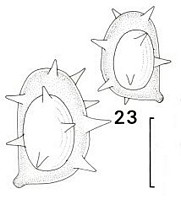|
 Clavaria echinobrevispora Clavaria echinobrevispora
BiostatusPresent in region - Indigenous. Endemic
Images (click to enlarge)
Caption: Fig 23 Clavaria echino-brevispora, spores, TENN no., 42483. Scale bar = 5 µm. |
Article: Petersen, R.H. (1988). The clavarioid fungi of New Zealand. New Zealand Department of Scientific and Industrial Research, Bulletin 236: 170 pp. Wellington:.
Description: Fruit bodies up to 30 x 1.5 mm, simple clubs, scattered to gregarious but not cespitose,
narrowly fusiform to cylindrical, arising from small white mycelial patches. Club pale yellow
at maturity, paler when young, subopaque, equal; apex rounded. Stipe concolourous to paler,
subtranslucent, equal.
Tramal hyphae hardly inflated, clampless, tightly packed, parallel; secondary septa common.
Subhymenium poorly developed. Hymenium hardly thickening, free; basidia 40-50 µm long,
clavate, attenuate below, clamped; contents minutely multiguttulate at maturity; sterigmata
4, spindly, divergent.
Spores 5.8-7.9 x 4.0-5.0 µm (E= 1.29-1.58; Em = 1.45; Lm = 6.75 µm), short cylindrical to
ellipsoid, spiny at maturity, thin-walled; contents uniguttulate at maturity, the guttule highly
refringent; hilar appendix small, not prominent; ornamentation of sharp, conical spines up to
2 µm long, sparsely scattered over spore surface.
Habitat: On soil and humus.
Notes: Taxa in subgenus Holocoryne with ellipsoid spiny spores are few. One, Clavaria echino-olivacea, produces white fruit
bodies and larger spores. The others, C. tuberculospora and C.
californica, produce yellowish fruit bodies, but in the former, spores are different in shape
(but see under that name for caveats), and those of C. californica are significantly larger.
Moreover, the hymenium in C. tuberculospora is agglutinated in dried specimens, making
the basidial clamp difficult to observe, whereas that of C. echino-brevispora is free and the
clamps are easy to see in squash mounts.
|